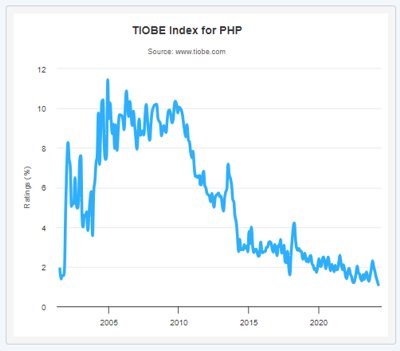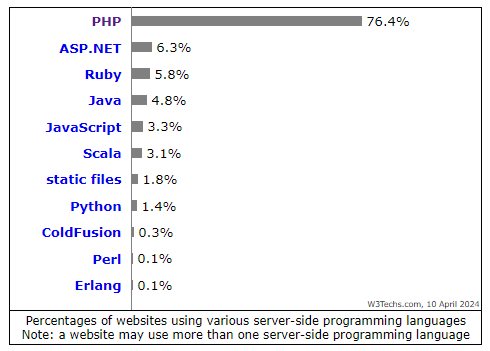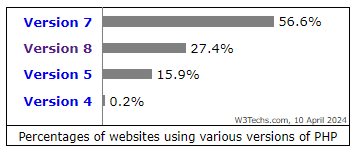| Is PHP in Trouble? |
| Written by Sue Gee |
| Wednesday, 10 April 2024 |
|
The April 2024 headline for the TIOBE Index, which ranks programming languages in terms of their popularity, reads, "Is PHP losing its mojo" asking this question because this month PHP has dropped out of the Top 10 for the first time in its history, and plunging dramatically to #17.
When I last reported on the TIOBE Index, two months ago in February 2024, see Golang Back In TIOBE Top 10, PHP was in #10, which was then its lowest ever position. In fact PHP first fell as low as 10th in the rankings in 2017 and had hovered close to the bottom of the Top 10 chart ever since. For example, in my report PHP - Essential But Underappreciated in September 2021, it was in 9th place in TIOBE. A fall from #10 to #17 suggests some kind of catastrophe for PHP, but this isn't really the case. The nature of the TIOBE index is that a language that goes down one month often bounces back the next, but this hasn't happened in the recent past to PHP. After its previous low rating of 1.27% in August 2023, PHP climbed for three months, achieving a rating of 2.01%, but has then experienced a decline for five months in a row until now when its rating is 1.09%. The TIOBE index records year-on-year changes of ratings and in the case of PHP in April 2024 this is just of -0.26%. This would not seem to merit a fall of 7 places, but all the languages below it in the table are experiencing positive change and are moving up! Of course, we know better than to place too much reliance on the TIOBE Index, which can reflect more on the hype surrounding a language than on what is really going on. So the question is: Given its decline in popularity is PHP less used than previously? To find out, let's take a look at the Usage Statistics and Market Share figures collected on a daily basis by Web Technology Surveys, which were also used for PHP - Essential But Underappreciated. When we looked at the Web Usage Statistics in 2021, PHP dominated as the server-side programming language with a market share of 78.8%. There has been a negligible decline of 3% since so that now its share stands at 76.4%. Its nearest rival is still ASP.NET. Whereas it had a share of 8.3% in 2021 it currently has just 6.3%, having experienced a decrease of 24% in the same period. Ruby, still has the same market share (5.8%) as in 2021, and the programs that have increased their share are Java, now 4.8% , and JavaScript, now 3.3%. This graphic from W3Techs illustrates how these five languages are distributed across websites by volume of traffic: PHP is heavily relied on by small to medium websites thanks to it powering Wordpress.com, but it also used by prominent heavyweights including Facebook.com, Microsoft.com and Wikipedia.org. One of problems with any active website is keeping its underlying code up to date and W3Techs' data shows that only 27.4% of users are on version 8 with more than twice as many on version 7. Version 8.1 is used by 41.2% of all the websites who use PHP version 8. Using outdated versions means not taking advantage of the powerful new features introduced more recently, some of which are outlined by Brent Roose, Developer Advocate for PhPStorm at JetBrains who promotes PHP on his stitcher.io blog and PHP Annotated YouTube channel: Since this video was posted we've seen PHP 8.3 Released and any decryers of PHP should look at what it offers rather than dismissing it as "messy" or "underpowered". More InformationRelated ArticlesPHP - Essential But Underappreciated PHP 8.1 Released With Enums, Read-Only Properties and Fibers PHP 8.0 Adds Metadata To Classes
|
| Last Updated ( Wednesday, 10 April 2024 ) |






